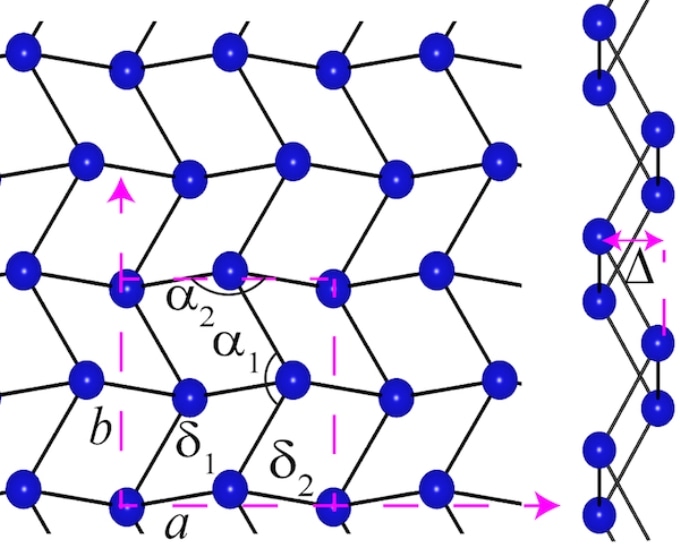Mar 12 2018
Researchers at Rice University and the Indian Institute of Science, Bangalore, have formulated a technique to make atomically flat gallium that exhibits promise for nanoscale electronics.
 A model of the structure of gallenene is shown after exfoliation from bulk gallium. Scientists at Rice University and the Indian Institute of Science, Bangalore, discovered a method to make atomically flat gallium that shows promise for nanoscale electronics. (Image credit: Ajayan Research Group)
A model of the structure of gallenene is shown after exfoliation from bulk gallium. Scientists at Rice University and the Indian Institute of Science, Bangalore, discovered a method to make atomically flat gallium that shows promise for nanoscale electronics. (Image credit: Ajayan Research Group)
The Rice lab of materials scientist Pulickel Ajayan and colleagues in India developed two-dimensional (2D) gallenene, a thin film of conductive material that is to gallium what the wonder material graphene is to carbon.
Extracted into a 2D form, the new material seems to have an attraction towards binding with semiconductors like silicon and could make a useful metal contact in 2D electronic devices, the researchers explained.
The new material was described in Science Advances.
Gallium is a metal having a low melting point; in contrast to graphene and many other 2D structures, it cannot still be grown using vapor phase deposition approaches. Furthermore, gallium also has a propensity to oxidize rapidly. It was possible to remove the early samples of graphene from graphite using adhesive tape, but the bonds between gallium layers are too robust for such a simple technique.
So the Rice researchers led by co-authors Vidya Kochat, a former postdoctoral researcher at Rice, and Atanu Samanta, a student at the Indian Institute of Science, used heat rather than force.
Instead of a bottom-up method, the team started from bulk gallium by heating it to 29.7 °C (about 85 °F), just below the melting point of the element and worked their way down. That was sufficient to drip gallium onto a glass slide. As a drop cooled a little bit, the researchers pressed a flat piece of silicon dioxide on top to lift a few flat layers of gallenene.
They effectively exfoliated gallenene onto other substrates, including gallium arsenide, gallium nitride, nickel, and silicone. That allowed them to verify that specific gallenene-substrate combinations have varied electronic properties and to propose that these properties can be tweaked for applications.
The current work utilizes the weak interfaces of solids and liquids to separate thin 2D sheets of gallium. The same method can be explored for other metals and compounds with low melting points.
Chandra Sekhar Tiwary - Chief Investigator & Assistant Professor at the Institute of Technology in Gandhinagar, India.
Gallenene’s plasmonic and other properties are being examined, according to Ajayan. “Near 2-D metals are difficult to extract, since these are mostly high-strength, nonlayered structures, so gallenene is an exception that could bridge the need for metals in the 2D world,” he said.
The paper’s co-authors are as follows: graduate student Yuan Zhang and Associate Research Professor Robert Vajtai of Rice; Anthony Stender, a former Rice postdoctoral researcher and now an assistant professor at Ohio University; Sanjit Bhowmick, Praveena Manimunda and Syed Asif of Bruker Nano Surfaces, Minneapolis; and Rice alumnus Abhishek Singh of the Indian Institute of Science. Ajayan is chair of Rice’s Department of Materials Science and NanoEngineering, the Benjamin M. and Mary Greenwood Anderson Professor in Engineering and a professor of chemistry.
The Air Force Office of Scientific Research funded the study, with extra support from the Indo-US Science and Technology Forum, the government of India and a Rice Center for Quantum Materials/Smalley-Curl Postdoctoral Fellowship in Quantum Materials.